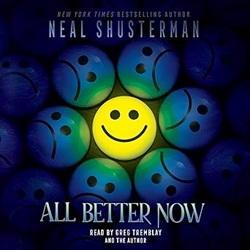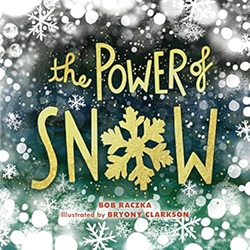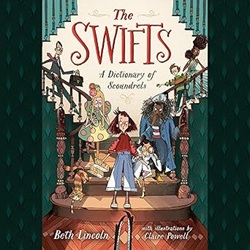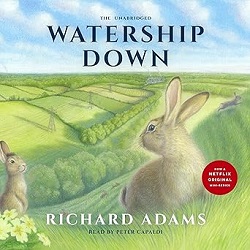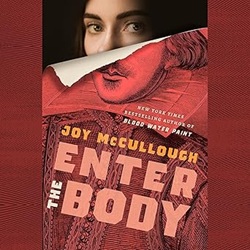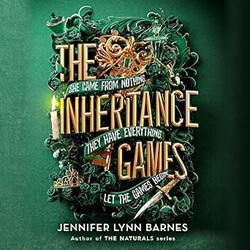Review of All Better Now, by Neal Shusterman
by Neal Shusterman
read by Greg Tremblay and Neal Shusterman
Simon & Schuster Audio, 2025. 14 hours, 10 minutes.
Review written May 9, 2025, from a library eaudiobook.
Starred Review
Neal Shusterman knows how to write epic dystopian series. I still think the Arc of a Scythe series is unmatched, but All Better Now is a promising beginning.
The scenario: In the near future, there’s another pandemic. This one is deadlier than COVID-19, but for those who recover – all their problems are over, as far as they’re concerned. They’re happy and content and they care about others.
This gets people in power concerned. The Recoverees aren’t motivated by fear or greed. They get things secondhand, give things away, open their homes to strangers. Economies across the world will collapse if this happens to too many people. Another downside: If a Recoveree sees someone in trouble, they rush to help – forgetting to check if they are actually capable of helping. This results in multiple deaths if the situation is dangerous enough.
The main characters of the book are three teens. Mariel has been living in her car with her mother. When her mother catches the virus, nowhere will take her except a community of Recoverees at the Pier, and Mariel becomes a part of that community. Rón is the son of a billionaire with a pretentious accent in his name. He’s always been prone to depression and has survived suicide attempts, so when his father wants to cloister their family to protect them from the virus, he decides getting the virus is the right choice for his mental health, whether his father likes it or not. And Morgan has always been ruthless, doing what it takes to get ahead. So she’s recruited by the head of a charitable foundation who has gotten the virus. The woman is afraid she’ll give all the money away – so she gives Morgan charge of the money and a commission to work on a vaccine and change the world. Sure enough, when the woman recovers, she wants to thwart those plans. But Morgan’s in control now. Or is she?
The greater forces at work in the world of the novel are certainly going to change humanity. Recoverees have found peace and happiness – and they want to pass those things on. But powerful folks have too much to lose, and they’ll take drastic steps to stop the virus, ethical or not. Meanwhile there’s plenty of tension and danger as our three main characters interact in this scenario. And I won’t say how the book ends – but let’s just say the story isn’t finished.
I read Book 2 of The Arc of a Scythe, Thunderhead, the year I was reading for the Newbery Medal Committee – and I still maintain that book had the best plotting of any book I read that year. (It’s not really a book for children in my opinion, which is another discussion. But the plotting is incredible!) This book also had a set up of many different threads in a grand tapestry.
I did have a caveat that held me back from complete enjoyment – I couldn’t bring myself to believe that every single person who recovered from the virus would have the same exact effect. I’m willing to buy the premise that some kind of brain damage could do that to you – maybe – because some stroke victims have reported feeling one with all mankind – so maybe? But after seeing COVID-19 have so many different effects on so many different people – it’s hard to believe that a new coronavirus would affect everyone who recovers from it in the same way. Also, nothing was said about variants, and people were sure they couldn’t get it a second time – and that all was harder for me to believe after coming through our last pandemic.
I also didn’t really believe in the idea of an alpha spreader – someone who could still shed virus after they’ve recovered. And never stopped shedding the virus, in fact. The existence of this possibility makes the book more interesting – but it’s still hard to believe.
But given the premise, the book presents an intriguing situation. What would happen to humanity if we all became happy and altruistic? Would our current governments and economies collapse? But might it not be true that something better would arise to take its place? If it happened, would you want to get the virus, despite the 4% fatality rate? Recoverees say that at least those who die, die happy.
I definitely believed the part about people stirring up propaganda against the Recoverees and starting conspiracy theories against them. And it was funny when ruthless folks trying to stop the virus got thwarted by the kind, altruistic folks. Because after all, what they have is good for humanity! I also felt like the author realistically showed people’s motivations changing – but their keeping their main personality and still being able to make choices, sometimes against their new instincts.
So as usual, besides an entertaining ride, Neal Shusterman gave me plenty of philosophical questions to mull over. Now the only problem is waiting for the next book to come out.
Find this review on Sonderbooks at: www.sonderbooks.com/Teens/all_better_now.html
Disclosure: I am an Amazon Affiliate, and will earn a small percentage if you order a book on Amazon after clicking through from my site.
Disclaimer: I am a professional librarian, but the views expressed are solely my own, and in no way represent the official views of my employer or of any committee or group of which I am part.
What did you think of this book?
